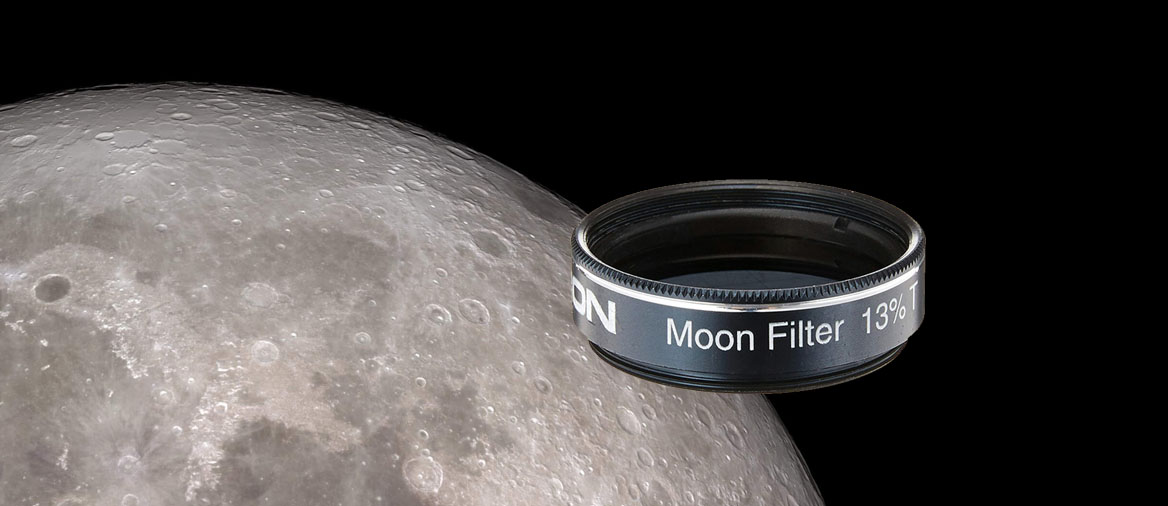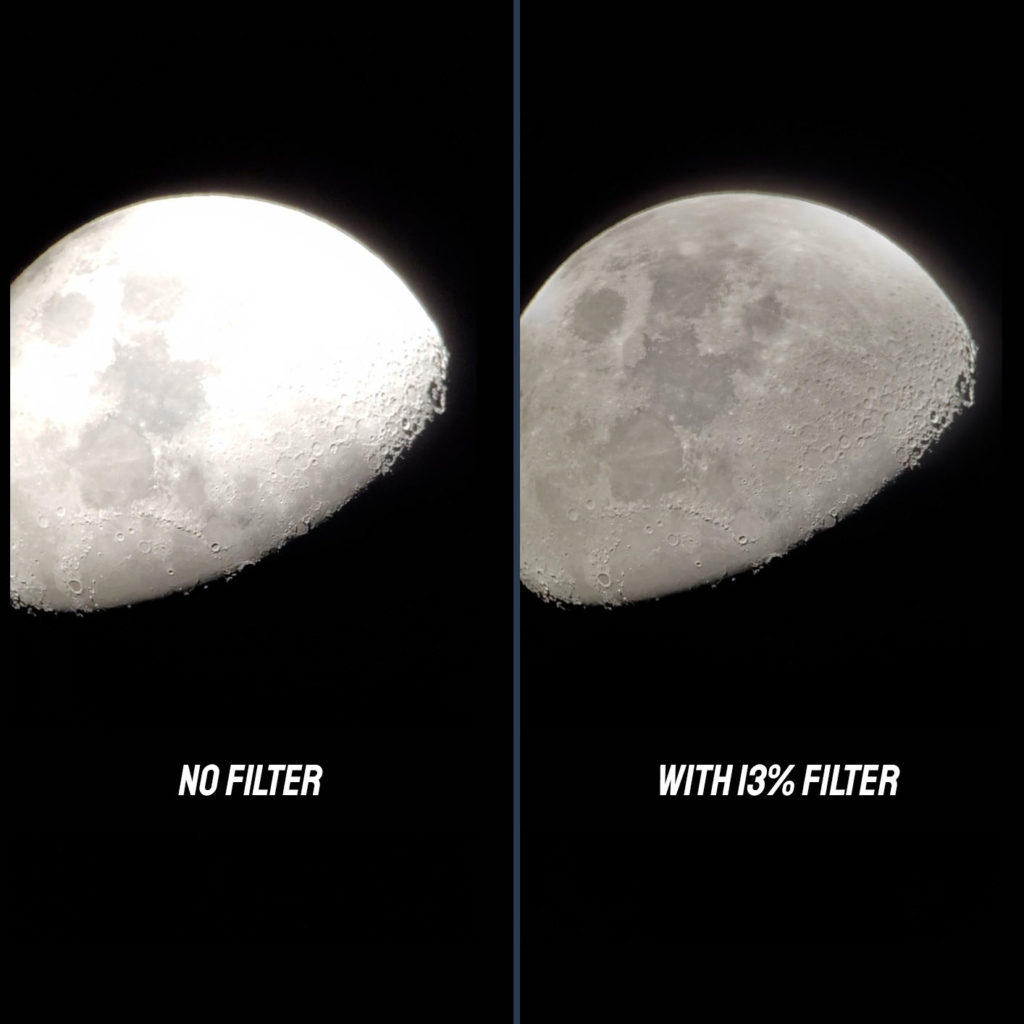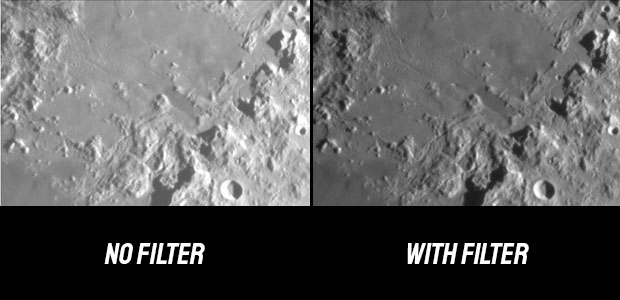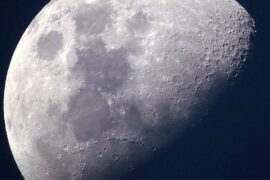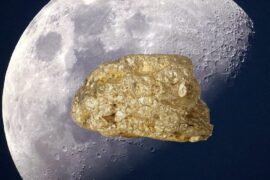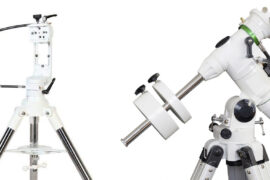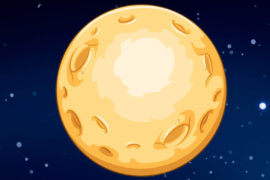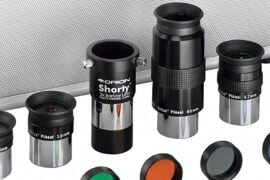One of the first things beginner stargazers will notice when looking at the Moon through a telescope for the first time is that it is much, much brighter than they were expecting. This often leads to the question. Is a Moon filter necessary? Will looking at the Moon without one hurt your eyes?
You do not need a filter to look at the Moon. It is safe for your eyes to observe it without one, even during a full moon when it’s at its brightest. That being said, there are times when using a filter can improve your viewing experience and give you more detail in the image.
Let’s explore when you might want to use a moon filter, but first things first.
What is a moon filter?
A moon filter is an accessory that can be attached to a telescope’s eyepiece. It is used to partially dim the light that is being captured by the lens of your telescope to reduce the brightness of the Moon, increasing the level of details that you can see. This can sound counter-intuitive because we tend to think that more brightness equals more detail in an image, but there is a point when too much brightness causes the image to lose as much detail and quality as too much darkness.
In other optics fields like photography, these types of filters are also commonly known as ND filters, where the ND stands for Neutral Density.
Moon filters can be found in 3 common transmissions. 13%, 18%, and 25%. The transmission refers to the amount of light the filter allows to go through, so a 13% filter will result in a dimmer image than a 25% filter.
Besides using it for lunar observation, moon filters can also be helpful in planetary viewing to get extra details out of Mars, Jupiter, and Saturn.
Moon filter comparison
To better understand the effect of a moon filter, take a look at the following comparison.
Please note that it can be hard to really appreciate a lot of the minor changes in detail in these photos because modern cameras make automatic adjustments on overexposed images, but it should give you an idea of why these natural density filters can be helpful when you want to better appreciate the geology of the Moon.
Pay attention to the upper right area in the picture above. Notice how many more craters appear in the image and how the depth and size of these rocky formations can be better appreciated.
Here’s another comparison with a bit more zoom. On the left the view with no filter, on the right with a neutral density filter.
As you can see, the image gains a lot more contrast, the shadows are more clearly defined, and some details that were lost to the brightness can be appreciated.
Should you get a moon filter?
The prices of moon filters are generally reasonable. Getting one is not going to break the bank, so even though getting one isn’t a priority, it is a purchase with good value, especially if your main objective when using your telescope is looking at the moon. There are other considerations that might help you decide if it’s a good idea to purchase one and if it’s worth it for you.
Maybe the most important factor to consider is the aperture of your telescope. In entry-level telescopes in the 3″-4″ inch range (70-100 mm) the brightness of even a full moon isn’t that bad. As the telescope captures more light with a higher aperture, the brightness can get quite uncomfortable, and using a filter might feel a lot better.
While looking at the Moon through a telescope without a filter is safe, the brightness can be uncomfortable for some people. Our suggestion is to test first and see how you feel about it.
Another case for moon filters is that if you are planning to look at the Moon early in the night, the brightness of the Moon can temporarily reduce your night vision because your eyes have to adapt to it. This means that for the objects you try to observe afterwards, your vision might take some time to adapt and you might not be able to distinguish as much detail in them.
Finally, if you really want to appreciate the geology of the Moon, with all its details, and locate the important craters and mountains, then a filter is almost a necessity as it will help you get the required level of detail. That very same filter can also be helpful for similar situations when you are trying to look at Mars.
Recommended moon filters.
When it comes to moon filters, the variation in quality between the premium ones and the budget options is really negligible. Overspending is not necessary, stay with the entry-level options.
Every filter should fit any eyepiece as long as the barrel is the same size. If your telescope uses the standard 1.25″ eyepieces, just make sure to get a filter of that same barrel size. If your telescope uses 2″ eyepieces, get a 2″ one, etc.
As for the transmission, there’s also no need to overthink too much between a 13%, 18%, or a 25% one. The difference isn’t that noticeable. Just get the 13%, and if eventually, as you gain more experience stargazing you feel like you need a 25% one, then buy it, but you will know when you get to that point.
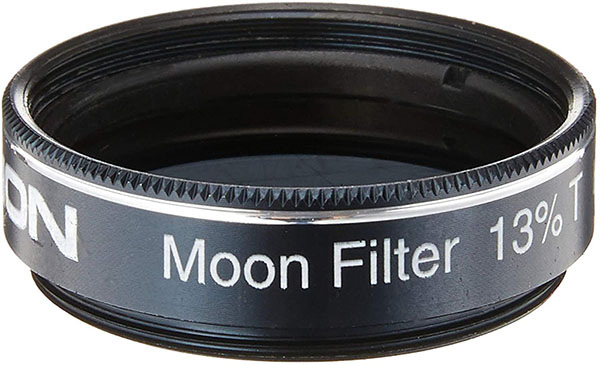
As for a specific recommendation, the Orion 05662 is a great product. It’s a 13% filter made with high-quality materials. It’s metallic so it doesn’t feel fragile and plastic-y like other options. The price is reasonable and not that far from the ultra-budget options.
Enjoyed this article?
Get daily 10-minute PDFs about astronomy to read before bed!
Sign up for our upcoming micro-learning service where you will learn something new about space and beyond every day while winding down.

